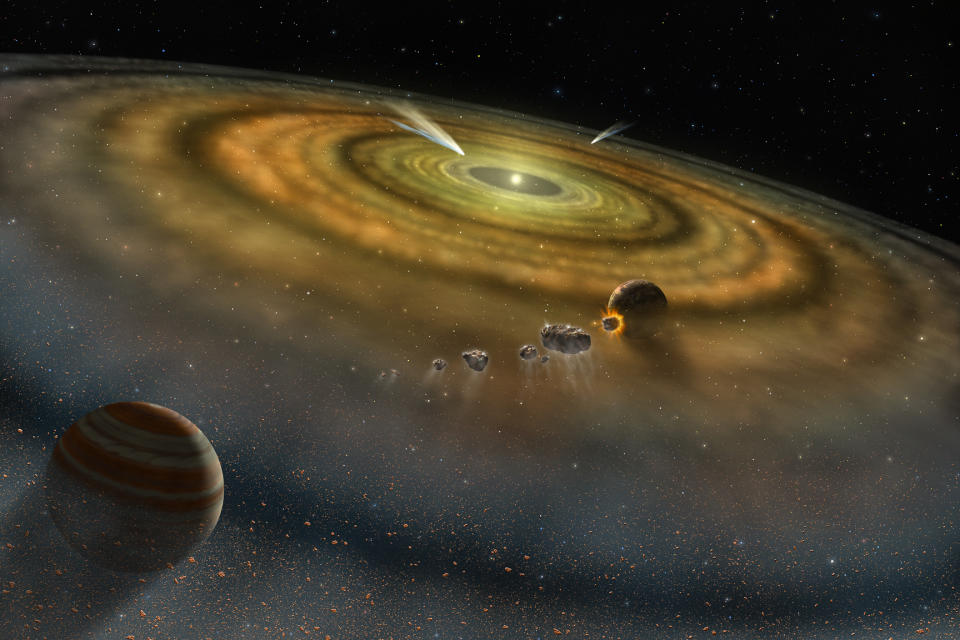Astronomers using the James Webb Space Telescope have discovered the richest hydrocarbon “menu” ever seen in the planet-forming disk. This observation, which involved a protoplanetary disk around a small star, also revealed the first detection of ethane outside the solar system.
The discovery was made while the Mid-Infrared instrument (MIRI) on the James Webb Space Telescope (JWST) was investigating the object “ISO-ChaI 147” as part of the Mid-Infrared Disk Survey (MINDS). ISO-ChaI 147 is a young star located in the Chameleon I star forming region, which contains approximately 237 stars. This region is located approximately 600 light years away.
These JWST observations of ISO-ChaI 147 imply that protoplanetary disks formed from small stars are more efficient at forming smaller, Earth-like planets than they are at giving birth to much larger, Jupiter-like gas giants. So, since low-mass stars are more common than massive stars in the Milky Way, there may be more terrestrial planets in our galaxy than previously suspected.
The findings also show that the planet-bearing clouds of gas and dust surrounding small stars form differently (at least chemically) from the clouds around stars about the size of the Sun and larger. The different chemical menu around these relatively small stars could mean that their rocky planets have atmospheres very different from those of Earth.
Relating to: Rogue planets may originate from ‘twisted Tatooine’ binary star systems
ISO-ChaI 147 has a mass of just over 10% of the mass of the Sun and is surrounded by a protoplanetary disk with carbon-rich chemistry containing 13 carbon-bearing molecules, including ethane and gasoline. However, the amount of oxygen-carrying molecules in this disc is quite low.
“This is extremely different from the composition we see in disks around solar-type stars, which are dominated by oxygen-carrying molecules such as water and carbon dioxide,” team member and researcher Inga Kamp from the University of Groningen said in a statement. .
The MINDS team thinks this indicates that material is transported radially across the proto-planetary disk of ISO-ChaI 147, thus affecting the bulk composition of any planets that form within the disk.

What does this mean for exoplanet hunting?
Stars are born when huge clouds of gas and dust form extremely dense patches and eventually collapse under their own gravity. But not all this material is used in this process, leading to baby stars being surrounded by rotating and flattened clouds of gas and dust called protoplanetary disks. When bits of matter in this disk condense, planets emerge; This is what happened around our baby sun about 4.6 billion years ago.
The amount of material in the protoplanetary disk and how that gas and dust is distributed puts a limit on how many planets a star can host, as well as what building blocks can provide those planets. JWST ISO-ChaI 147 results show that this protoplanetary disk is more suitable for the birth of smaller rocky planets rather than larger gas giants.
Because environments in protoplanetary disks determine the conditions under which new planets form, the finding that disks surrounding very low-mass stars evolve differently than those around more massive stars has potential implications for finding rocky planets with Earth-like properties. However, small stars may host planets that are similar to Earth in many respects but radically different in others.


“Many primary atmospheres of these planets will probably be dominated by hydrocarbon compounds and not very abundant in oxygen-rich gases such as water and carbon dioxide,” said Thomas Henning, MINDS team leader and researcher at the Max Planck Institute for Astronomy (MPIA). , drew attention in the statement. “In a previous study, we showed that the transport of carbon-rich gas into the region where terrestrial planets form is faster and more efficient in these disks than in the disks of larger stars.”
The reason for the carbon and oxygen imbalance between protoplanetary disks of stars with different masses is not yet understood. For example, it could be the result of disks around smaller stars becoming enriched with carbon or depleted of oxygen.
If the first is true, this means that carbon enrichment can occur as solid particles in the disk are stripped of their carbon content. This ingredient will be released as gas. These carbon-deprived solid particles will continue to form planets with carbon-poor rocky bodies. However, the atmospheres of these worlds will be carbon-heavy due to the excess of carbon gas in the environment where they were born. So these rocky planets around tiny stars will ultimately be rich in carbon and quite different from Earth.
Research leader Aditya Arabhavi of the University of Groningen added that these findings were possible thanks to JWST’s unique location approximately one million miles (1.6 million kilometers) from Earth.
“These observations are not possible to make from Earth because the associated gas emissions are absorbed by the atmosphere,” Arabhavi said. said. “Previously, we could only identify acetylene emission from this object. But JWST’s higher sensitivity and the spectral resolution of its instruments allowed us to detect weak emission from less abundant molecules.”
RELATED STORIES:
— A ‘captured’ alien planet may be hiding at the edge of our solar system — and it’s not ‘Planet X’
— 400 Earth-sized rogue planets may be roaming the Milky Way
— A cosmic ‘fossil record’ may be hidden among orphan stars
The MINDS team now plans to search for more protoplanetary disks around low-mass stars. This will help us determine how common exotic, carbon-rich terrestrial planet-forming regions like ISO-ChaI 147 actually are.
“Expanding our work will also allow us to better understand how these molecules might form,” Henning said. “Several features in the data are also still unidentified and warrant additional spectroscopy to fully interpret our observations.”
The team’s research was published Thursday, June 6, in the journal Science.